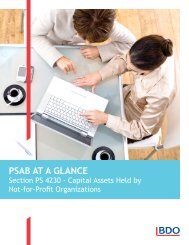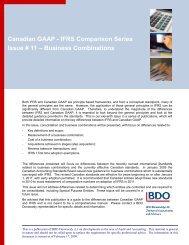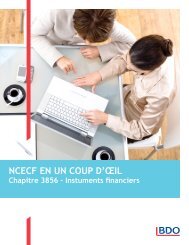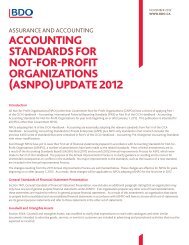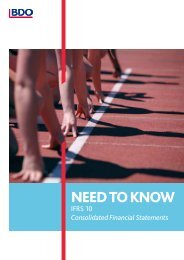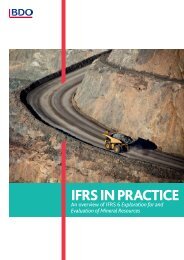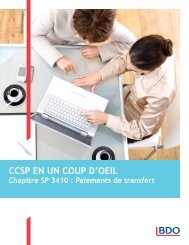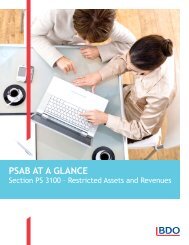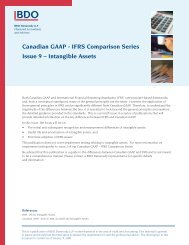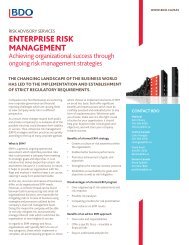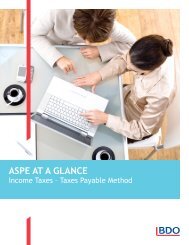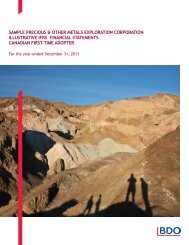need to know / leases - project update - BDO International
need to know / leases - project update - BDO International
need to know / leases - project update - BDO International
You also want an ePaper? Increase the reach of your titles
YUMPU automatically turns print PDFs into web optimized ePapers that Google loves.
NEED TO KNOW<br />
Leases — A Project Update
2 LEASES - A PROJECT UPDATE<br />
TABLE OF CONTENTS<br />
Introduction 3<br />
Existing guidance and the rationale for change 4<br />
The IASB/FASB <strong>project</strong> <strong>to</strong> date 5<br />
The main proposals 6<br />
Definition of a lease 6<br />
When would a contract contain a lease? 6<br />
What would be the lease term? 6<br />
What would be a ‘significant economic incentive’? 7<br />
Scope 8<br />
Contracts that contain lease and non-lease components 8<br />
Lessee accounting 9<br />
Initial recognition and measurement 9<br />
Subsequent accounting 10<br />
Accounting for the lease 11<br />
Presentation 15<br />
Lessor accounting 16<br />
Recognition and measurement 16<br />
‘Operating lease’ approach 19<br />
Presentation 19<br />
Amounts included in lease payments 20<br />
Variable lease payments 20<br />
Purchase options 21<br />
Residual value guarantees 21<br />
Term option penalties 21<br />
Reassessment of the discount rate 22<br />
Short term <strong>leases</strong> 22<br />
Sale and leaseback transactions 22<br />
Disclosure 23<br />
Consequential amendments – business combinations 24<br />
Transition 25<br />
Lessees 25<br />
Lessor 25
LEASES - A PROJECT UPDATE<br />
3<br />
INTRODUCTION<br />
This publication sets out key proposals about the future of lease accounting, based on the most recent discussions of the<br />
IASB and the FASB during their joint <strong>project</strong> <strong>to</strong> revise the accounting requirements. If, as appears likely, the proposals are<br />
finalised on the basis of decisions taken <strong>to</strong> date, a wide range of entities will be affected. In summary:<br />
Lessees<br />
––<br />
Lessees would record assets and liabilities for a wide range of <strong>leases</strong> that are currently not recognised on balance sheet<br />
––<br />
For <strong>leases</strong> of items that are currently accounted for as operating <strong>leases</strong>, except for <strong>leases</strong> of real estate, the single amount<br />
currently included within operating results in the income statement will be split in<strong>to</strong> operating and finance components<br />
––<br />
For <strong>leases</strong> of real estate, although assets and liabilities will be recognised on balance sheet, the lease expense recognised<br />
in profit or loss will continue <strong>to</strong> be on the same basis as under IAS 17 Leases, in most cases resulting in a constant expense<br />
over the lease term.<br />
Lessors<br />
––<br />
For many <strong>leases</strong> except most <strong>leases</strong> of real estate, lessors would adopt a ‘receivable and residual’ approach, with the leased<br />
asset being partially derecognised and a separate lease receivable being recognised<br />
––<br />
For <strong>leases</strong> of real estate, in many cases an approach similar <strong>to</strong> operating lease accounting in accordance with IAS 17 would<br />
be retained.<br />
For some entities, the effect on their financial statements will be very significant, with this extending <strong>to</strong> include not only the<br />
statement of financial position (or balance sheet) but also their comprehensive income and cash flow statements. Although<br />
a finalised accounting standard is not expected <strong>to</strong> be effective on a manda<strong>to</strong>ry basis before 2015, we now <strong>know</strong> enough<br />
about the IASB’s tentative decisions <strong>to</strong> have a fairly clear picture of the revised proposals. Given the extent of outreach and<br />
discussion with constituents, it appears likely that the revised exposure draft will contain many proposals that will be taken<br />
forward.<br />
Consequently, entities should start <strong>to</strong> assess the effect of the proposals on their financial statements, and in particular the<br />
consequent effect on related arrangements including:<br />
––<br />
Lending agreements, including key ratios and covenants<br />
––<br />
Employee remuneration arrangements, including bonus schemes linked <strong>to</strong> reported profits and share-based payments; and<br />
––<br />
Inves<strong>to</strong>r communications.<br />
The revised exposure draft is expected <strong>to</strong> be issued before the end of 2012, with a comment period of 120 days.
4 LEASES - A PROJECT UPDATE<br />
EXISTING GUIDANCE AND<br />
THE RATIONALE FOR CHANGE<br />
The existing accounting models under both IFRS and US GAAP require lessees <strong>to</strong> classify their lease contracts as either<br />
finance (capital) <strong>leases</strong> or operating <strong>leases</strong>. Under a finance lease, a lessee recognises the leased asset on balance sheet<br />
<strong>to</strong>gether with a corresponding lease liability which is subsequently accounted for as a financing transaction. Under an<br />
operating lease, leased assets and related gross liabilities are not recognised, with only a lease expense being recognised<br />
in profit or loss (usually on a straight line basis over the lease term). Under IFRS, the distinction between a finance and an<br />
operating lease is based on whether the lease transfers substantially all of the risks and rewards associated with the leased<br />
asset <strong>to</strong> the lessee. Under US GAAP, although specified criteria are used <strong>to</strong> determine the classification, the result is typically<br />
the same as under IFRS although the US GAAP ‘bright line’ thresholds can result in differences for some transactions.<br />
These models have been criticised for failing <strong>to</strong> meet the <strong>need</strong>s of users of financial statements, because, unless a lease<br />
is classified as a finance lease, rights and obligations that meet the definitions of assets and liabilities in the IASB and<br />
FASB conceptual frameworks are omitted from balance sheets. Transactions are frequently structured specifically <strong>to</strong><br />
result in operating lease classification, and hence <strong>to</strong> avoid recording associated assets and liabilities. This leads <strong>to</strong> a lack of<br />
comparability and, because of the structuring of transactions <strong>to</strong> achieve a particular accounting result, <strong>to</strong> complexity. As a<br />
result, many users of financial statements adjust amounts presented in financial statements <strong>to</strong> reflect assets and liabilities<br />
arising from arrangements classified as operating <strong>leases</strong>.
LEASES - A PROJECT UPDATE<br />
5<br />
THE IASB/FASB PROJECT TO DATE<br />
In order <strong>to</strong> address the criticisms set out above, the IASB and the FASB (the Boards) initiated a joint <strong>project</strong> <strong>to</strong> develop a<br />
new approach <strong>to</strong> lease accounting that would result in most, if not all, assets and liabilities arising from lease contracts<br />
being recognised in an entity’s statement of financial position. While the main focus was on lessee accounting, proposals<br />
were also developed for changes <strong>to</strong> lessor accounting. An exposure draft (the ED) was issued in August 2010 which set out<br />
an accounting approach based on the premise that lease contracts result in lessees obtaining the right <strong>to</strong> use an asset for a<br />
specified period (the ‘right of use’ model). The proposals were controversial, and the Boards received almost 800 comment<br />
letters.<br />
In addition <strong>to</strong> publishing the ED for comment, the Boards:<br />
––<br />
Initiated over 200 outreach meetings, including 7 round tables and 15 preparer workshops<br />
––<br />
Prepared questionnaires that were completed by over 250 lessors and over 400 lessees<br />
––<br />
Carried out targeted outreach during redeliberations with over 70 organisations.<br />
There was general support for the proposed ‘right of use’ model. However, the feedback received also included many<br />
comments that the detailed approach proposed in the ED was <strong>to</strong>o complex, inconsistent with the economics underlying<br />
certain transactions and, for many companies, excessively costly <strong>to</strong> implement. In particular, there were concerns about<br />
complexity of measurement, costs associated with required reassessments during lease terms, accounting for multi element<br />
contracts (contracts which contain lease and non-lease components) and the proposed lessor accounting model. During<br />
their redeliberations, the Boards have made significant changes <strong>to</strong> the proposals set out in the ED. Consequently, as noted<br />
above, the proposals will be re-exposed in order <strong>to</strong> provide interested parties with an opportunity <strong>to</strong> comment on revisions<br />
that the Boards have proposed.<br />
<strong>BDO</strong> comment<br />
The Boards have addressed many of the concerns raised by constituents in response <strong>to</strong> the original proposals, and this has<br />
resulted in simplifications being made <strong>to</strong> the proposed model which would assist in making them more straightforward <strong>to</strong><br />
implement. We welcome these developments. However, the proposals that we expect <strong>to</strong> be re-exposed for comment also<br />
include what some might regard as a compromise for <strong>leases</strong> of real estate. While we believe that the proposals would continue<br />
<strong>to</strong> bring a significant improvement <strong>to</strong> the quality of financial reporting, the extent of this improvement in accounting for <strong>leases</strong><br />
of real estate would be more limited. The revised proposals for lessor accounting are also complex, and we anticipate that there<br />
may be calls for further simplification of the model in responses <strong>to</strong> the revised exposure draft.
6 LEASES - A PROJECT UPDATE<br />
THE MAIN PROPOSALS<br />
The main objective of the <strong>project</strong> has been maintained, which is that for most <strong>leases</strong> with a term of one year or more lessees<br />
will record assets and liabilities. There will be two approaches <strong>to</strong> be followed <strong>to</strong> determine the amounts <strong>to</strong> be recorded in<br />
profit or loss; one will result in a higher overall charge in the early periods of a lease due <strong>to</strong> the effect of finance charges<br />
on the lease liability which will decline as the obligation declines over the lease term, while the other will normally result<br />
in an overall constant charge <strong>to</strong> profit or loss over the lease term. The model <strong>to</strong> be followed will depend on the extent of<br />
consumption of the leased asset over the lease term.<br />
For lessors, there will also be two approaches which will be based on the same classification criteria used by lessees. One<br />
approach will result in the recording of the sale of part or all of the leased asset, while the other will result in accounting that is<br />
similar <strong>to</strong> current guidance for operating <strong>leases</strong>.<br />
<strong>BDO</strong> comment<br />
We believe that clear application guidance will <strong>need</strong> <strong>to</strong> be included in the revised proposals, in particular in respect of the new<br />
concept of the ‘extent of consumption of the leased asset’, as the accounting result under each of the two approaches may be<br />
significantly different.<br />
DEFINITION OF A LEASE<br />
When would a contract contain a lease?<br />
An entity would determine whether a contract contains a lease on the basis of the substance of the contract, by assessing<br />
whether the fulfilment of the contract depends on the use of a specified asset (an asset that is explicitly or implicitly<br />
identifiable) and whether the contract conveys the right <strong>to</strong> control the use of that specified asset for a period of time. A right<br />
<strong>to</strong> control the use of an asset is conveyed if the lessee has the ability <strong>to</strong> direct the use, and receive the benefit from that use<br />
throughout the lease term.<br />
The requirement for the arrangement <strong>to</strong> cover a specified asset is an important distinction, as it means that it would be<br />
necessary <strong>to</strong> be able specifically <strong>to</strong> identify the asset (for example, an item of plant and machinery or a building). A physically<br />
distinct portion of a larger asset could also be a specified asset (for example, the first floor of a building, floors 10 <strong>to</strong> 15 of a<br />
20 s<strong>to</strong>rey building or an indentified 100 square metre area of a 1,000 square metre commercial space). However, if a portion<br />
of an asset cannot be specifically identified (for example, a specified proportion of the capacity of a pipeline or of a fibre<br />
optic cable network) that portion is not a specified asset.<br />
What would be the lease term?<br />
The lease term would be the non-cancellable period for which the lessee has contracted with the lessor <strong>to</strong> lease the<br />
underlying asset, <strong>to</strong>gether with the effect of any options <strong>to</strong> extend or terminate the lease when there is a ‘significant<br />
economic incentive’ for an entity <strong>to</strong> exercise an option <strong>to</strong> extend the lease, or for an entity not <strong>to</strong> exercise an option <strong>to</strong><br />
terminate the lease.
LEASES - A PROJECT UPDATE<br />
7<br />
What would be a ‘significant economic incentive’?<br />
In assessing whether there is a significant economic incentive <strong>to</strong> exercise an extension or termination option, a lessee<br />
and a lessor would consider contract-based terms (terms that are included in the lease contract), asset-based fac<strong>to</strong>rs (for<br />
example significant leasehold improvements made by the lessee that might have material value when a lease extension<br />
option is due <strong>to</strong> be exercised and would be lost if the lessee exercised the termination option) and entity-based fac<strong>to</strong>rs (for<br />
example management intent). All these fac<strong>to</strong>rs would be considered <strong>to</strong>gether and the existence of only one fac<strong>to</strong>r would not<br />
necessarily, by itself, signify a significant economic incentive <strong>to</strong> exercise an option.<br />
The lease term would be reassessed only when there is a significant change in relevant fac<strong>to</strong>rs, meaning that the lessee would<br />
either now have, or no longer have, a significant economic incentive <strong>to</strong> exercise an option.<br />
The thresholds for evaluating a lessee’s economic incentive <strong>to</strong> exercise options <strong>to</strong> extend or terminate a lease and options <strong>to</strong><br />
purchase the underlying asset would be the same for both initial and subsequent assessment. However, changes in market<br />
rental rates after lease commencement would not be included in the analysis.<br />
<strong>BDO</strong> comment<br />
The Boards’ decision <strong>to</strong> exclude future changes in market rental rates from the analysis when reassessing whether there is a<br />
significant economic incentive <strong>to</strong> exercise options <strong>to</strong> extend or terminate a lease might initially seem odd. However, this was<br />
in response <strong>to</strong> comments received by the Boards that, if changes in market rental rates were included in the analysis, this could<br />
result in excessive complexity in financial reporting. This is because the effect could be excessive volatility in the carrying<br />
amounts of assets and liabilities, as part or all of the arrangements subsequently fell within or moved outside the recognition<br />
threshold.<br />
What is not yet entirely clear from the Boards’ discussion is the linkage between market rental rates and management intent,<br />
as the latter would be taken in<strong>to</strong> account. The IASB Staff included the following example <strong>to</strong> support the decision <strong>to</strong> exclude<br />
changes in market rental rates (IASB Board paper, May 2011):<br />
Lessee A has a 10-year lease for its corporate headquarters in a large metropolitan area with annual payments of CU150,000.<br />
The lease has a 5-year renewal option at the same annual payment of CU150,000. During the 10 years, the following occurs <strong>to</strong><br />
annual market rates for the lease of comparative real estate:<br />
(a) At the end of year 3, there is an increase in demand. The annual market rate increases <strong>to</strong> CU300,000.<br />
(b) At the end of year 6, a local recession drives the annual market rate <strong>to</strong> CU50,000 per year.<br />
(c) At the end of year 8, because of tax incentives instituted by the local jurisdiction <strong>to</strong> stimulate the economy, an increase in<br />
demand results in the market rate increasing <strong>to</strong> CU320,000 per year.<br />
(d) At the end of year 10, the market rate is still CU320,000. However, Lessee A has decided that it has changed its business<br />
model <strong>to</strong> lower costs by decentralizing its management. It now estimates that it <strong>need</strong>s a much smaller space for its<br />
corporate headquarters and does not exercise the option <strong>to</strong> extend the lease term.<br />
The example does illustrate that, if market rental rates were <strong>to</strong> be taken in<strong>to</strong> account it would be possible for the assessment<br />
of whether the extension option would be exercised <strong>to</strong> change on a number of occasions. This would result in the five year<br />
extension period being included or excluded from the lease asset and liability at various points. However, it does not clearly<br />
address the potential for management <strong>to</strong> decide <strong>to</strong> relocate, and also exercise the lease extension option with the intention of<br />
subletting the existing premises at a profit.
8 LEASES - A PROJECT UPDATE<br />
SCOPE<br />
The proposed scope means that the new requirements would apply <strong>to</strong> all <strong>leases</strong> (including sub<strong>leases</strong>) except for:<br />
––<br />
Leases for the right <strong>to</strong> explore for or use minerals, oil, natural gas and similar non-regenerative resources<br />
––<br />
Leases of biological assets<br />
––<br />
Leases of service concession arrangements within the scope of IFRIC 12 Service Concession Arrangements<br />
––<br />
Short term <strong>leases</strong> (these are <strong>leases</strong> with a maximum possible term, including any options <strong>to</strong> renew, of 12 months or less).<br />
This means that <strong>leases</strong> of noncore assets (that is, assets not related <strong>to</strong> an entity’s main business activities), and long term <strong>leases</strong><br />
of land, would be within the scope of the proposals. In addition, there is no scope exclusion for assets that are often treated as<br />
inven<strong>to</strong>ry, such as non-depreciating spare parts, operating materials, and supplies, if these are associated with the leasing of<br />
another underlying asset. This may represent a significant further change for some entities.<br />
Although not specifically within the scope of the proposals, intangible assets are noted as not being required <strong>to</strong> be accounted<br />
for in accordance with the <strong>leases</strong> standard. This means that it would appear that an entity will have an option <strong>to</strong> apply the new<br />
requirements <strong>to</strong> <strong>leases</strong> of intangibles. It is not yet clear whether the approach adopted would <strong>need</strong> <strong>to</strong> be applied <strong>to</strong> all leased<br />
intangibles, or whether an entity would have a choice on an individual leased asset basis.<br />
CONTRACTS THAT CONTAIN LEASE AND<br />
NON-LEASE COMPONENTS<br />
For contracts that contain lease and non-lease components, the proposals would require each component <strong>to</strong> be identified<br />
and accounted for separately.<br />
A lessee would allocate payments due under the overall contract as follows:<br />
––<br />
If the purchase price of each component is observable, the lessee would allocate the payments on the basis of the relative<br />
purchase prices of individual components.<br />
––<br />
If the purchase price of one or more, but not all, of the components is observable, the lessee would allocate the payments<br />
on the basis of a residual method.<br />
––<br />
If there are no observable purchase prices, the lessee would account for all the payments required by the contract as a<br />
lease.<br />
Application guidance is <strong>to</strong> be included in the proposals, <strong>to</strong> assist lessees in determining what is meant by an ‘observable<br />
price’. This will take account of guidance that is planned <strong>to</strong> be included in other <strong>project</strong>s, in particular for revenue recognition.<br />
A lessor would allocate payments <strong>to</strong> be received in accordance with the guidance on revenue recognition.
LEASES - A PROJECT UPDATE<br />
9<br />
LESSEE ACCOUNTING<br />
Initial recognition and measurement<br />
At the date of commencement of a lease, a lessee would recognise and measure a right-of-use asset and a liability <strong>to</strong> make<br />
lease payments. The date of commencement of a lease is the date on which the lessor makes the underlying asset available<br />
for use by the lessee.<br />
The date of commencement of a lease may be different from the date of inception of the lease, which is the earlier of the<br />
date of the lease agreement and the date of commitment by the lessor and lessee <strong>to</strong> the principal terms of the lease; this<br />
can be earlier than the commencement date. In the 2010 ED, the IASB made a distinction between the recognition date<br />
(commencement of lease) and the date on which the lease assets and liabilities would be measured, which was the date of<br />
inception of the lease. This was similar <strong>to</strong> existing guidance in IAS 17. This approach was eliminated during redeliberations<br />
by the boards. Application guidance is <strong>to</strong> be included <strong>to</strong> cover costs incurred, and lease payments made, by lessees after the<br />
date of inception of a lease but before its commencement date. In addition, a lease might meet the definition of an onerous<br />
contract between its date of inception and date of commencement, meaning that the costs of the lease are greater than the<br />
economic benefits <strong>to</strong> be received from the use of the leased asset. In those cases, it would be accounted for in accordance<br />
with IAS 37 Provisions, Contingent Liabilities and Contingent Assets until the date of commencement.<br />
A lessee would measure its obligation <strong>to</strong> make lease payments at the present value of the lease payments, discounted using<br />
the lessee’s incremental borrowing rate or, if it can be readily determined, the rate the lessor charges the lessee.<br />
The lessee’s incremental borrowing rate is the rate of interest that, at the date of inception of the lease, the lessee would<br />
have <strong>to</strong> pay <strong>to</strong> borrow over a similar term, and with a similar security, the funds necessary <strong>to</strong> purchase a similar underlying<br />
asset.<br />
The right-of-use asset is measured at the amount of the obligation <strong>to</strong> make lease payments, plus any initial direct costs<br />
incurred by the lessee. Initial direct costs are those costs that are directly attributable <strong>to</strong> negotiating and arranging a lease,<br />
that would not have been incurred had the lease transaction not been entered in<strong>to</strong>.<br />
Any lease incentives provided by the lessor <strong>to</strong> the lessee would be deducted from the initial measurement of the right-ofuse<br />
asset. Where a right-of-use asset is amortised on a straight line basis <strong>to</strong> a nil residual value, the accounting result for the<br />
incentive will be the same as under current guidance in SIC-15 Operating Leases – Incentives, but it will be different where<br />
amortisation is not on a straight line basis.
10 LEASES - A PROJECT UPDATE<br />
Subsequent accounting<br />
The subsequent accounting would depend on the nature of the underlying asset. There would be two types of <strong>leases</strong>, with<br />
the classification being based on the extent of consumption of the leased asset during the lease term.<br />
Determining the type of lease<br />
The two proposed types of <strong>leases</strong> are:<br />
––<br />
The finance approach (or the interest and amortisation approach, or accelerated expense approach)<br />
––<br />
The straight line approach.<br />
While this would appear similar <strong>to</strong> the current finance vs operating lease distinction, the distinction between the two types<br />
of lease under the proposals would be different.<br />
The underlying principle in distinguishing between the approaches would be based on whether the lessee acquires and<br />
consumes more than an insignificant portion of the underlying asset over the lease term. If it does then the transaction<br />
would be looked at as a ‘financing transaction’ and the income statement would reflect a pattern of financing income or<br />
expense.<br />
The principle would be applied using a practical expedient based on the nature of the underlying asset, such that <strong>leases</strong> of<br />
property (including land and/or a building or part of a building) would be accounted for using the straight line approach<br />
unless:<br />
––<br />
The lease term is for the major part of the economic life of the underlying asset; or<br />
––<br />
The present value of fixed lease payments accounts for substantially all of the fair value of the underlying asset.<br />
Leases of assets other than property would be accounted for using the finance approach (accelerated expense) unless:<br />
––<br />
The lease term is an insignificant portion of the economic life of the underlying asset; or<br />
––<br />
The present value of the fixed lease payments is insignificant relative <strong>to</strong> the fair value of the underlying asset.<br />
During an IASB webcast in July 2012, the Staff presented a slide with the following examples:<br />
Truck (4 years) 3<br />
Vessel (20 years) 1 Vessel (5 years) 1<br />
More than Insignificant<br />
Car (3 years) 4<br />
Commercial property<br />
(30 years) 1<br />
Insignificant<br />
Commercial property<br />
(10 years) 1<br />
Aeroplane (8 years) 2<br />
Assumed economic life:<br />
1. 40 years 2. 25 years 3. 10 years 4. 6 years<br />
<strong>BDO</strong> comment<br />
It would appear that most <strong>leases</strong> (except for <strong>leases</strong> of real estate) would be regarded as being for more than an insignificant<br />
portion of the underlying asset and would therefore be accounted for under the finance approach. For example, the slide<br />
indicates that, if a the lease term of a vessel is five years and the assumed economic life 40 years, the staff believes that there<br />
is <strong>need</strong> for further judgment since this might suggest that the lessee consumes more than an insignificant portion of the<br />
underlying asset over the lease term.
LEASES - A PROJECT UPDATE<br />
11<br />
Accounting for the lease<br />
Under both the finance and straight line approaches, the lessee would measure the liability <strong>to</strong> make lease payments at<br />
amortised cost using the effective interest method and the right-of-use asset at amortised cost (subject <strong>to</strong> impairment),<br />
unless it was <strong>to</strong> be revalued.<br />
The difference between the two approaches is the way in which the right-of-use asset would be measured after initial<br />
recognition, and the associated effect on the income statement.<br />
Under the finance approach, the right-of-use asset would be amortised on the same basis that the lessee would apply <strong>to</strong> the<br />
underlying asset (and therefore in a way that reflects the pattern of consumption of the expected future economic benefits<br />
of the right-of-use asset). The lease liability would be accounted for using the effective interest method (that is, in the same<br />
way as a conventional loan). Interest and amortisation expenses would be recognised separately in the income statement.<br />
<strong>BDO</strong> comment<br />
Assuming the right-of-use asset was amortised on a straight line basis, the effect would be that the overall income statement<br />
charge would be greater in the early periods of a lease in comparison with later periods, due <strong>to</strong> the larger interest expense.<br />
This ‘front loading’ would be increased if the right-of-use asset was amortised on a reducing balance basis. In addition, the<br />
amortisation expense will be included within operating results, with the interest expense being included within finance charges.<br />
Assuming the arrangement would be accounted for as an operating lease under IAS 17, in addition <strong>to</strong> the ‘front loading’ of the<br />
combined amortisation and finance charge, the finance element will be eliminated from operating results. Entities will <strong>need</strong> <strong>to</strong><br />
consider carefully the effect on their reported results, and the associated effect on aspects such as bank covenants, employee<br />
remuneration arrangements linked <strong>to</strong> reported results (including share-based payments), and on key metrics that they report<br />
<strong>to</strong> the markets and other users of their financial statements.<br />
Under the straight-line approach the amortisation of the right-of-use asset is measured each period as a balancing figure<br />
such that the <strong>to</strong>tal lease expense would be recognised on a straight-line basis, regardless of the timing of lease. In addition,<br />
and in contrast <strong>to</strong> the finance approach, the two components of the lease expense would be recognised as one single<br />
amount <strong>to</strong> be charged <strong>to</strong> operating results in the income statement.<br />
A lessee may have a significant economic incentive <strong>to</strong> exercise a purchase option. In such cases, because the lessee would<br />
be assumed <strong>to</strong> acquire the underlying asset, the right-of-use asset that is recognised by the lessee would be amortised over<br />
the whole economic life of the underlying asset rather than over the lease term.<br />
The following examples illustrate the difference between the finance and straight line approaches.
12 LEASES - A PROJECT UPDATE<br />
Example 1 – illustration with equal lease payments in each period<br />
A lease contains the following key terms:<br />
––<br />
Lease term: 6 years<br />
––<br />
Lease payments: Annual payments, made at the end of each year, of CU75<br />
––<br />
Lessee incremental borrowing rate: 4%.<br />
The effect on the lessee’s statements of financial position and comprehensive income is as follows:<br />
Periods 0 1 2 3 4 5 6 Total expenses<br />
FINANCE APPROACH<br />
Balance sheet<br />
Right-of-use assets 393 (1) 328 (5) 262 197 131 66 0<br />
Liability <strong>to</strong> make lease payments 393 (1) 334 (4) 272 208 141 72 0<br />
Income statement<br />
Interest on lease obligation (2) 16 13 11 8 6 3<br />
Amortisation expense (3) 65.5 65.5 65.5 65.5 65.5 65.5 393<br />
Total lease expense 82 79 76 74 71 68 450<br />
STRAIGHT-LINE APPROACH<br />
Balance sheet<br />
Right-of-use assets 393 (1) 334 272 208 141 72 0<br />
Liability <strong>to</strong> make lease payments 393 (1) 334 (4) 272 208 141 72 0<br />
Income statement<br />
Total lease expense 75 (6) 75 75 75 75 75 450<br />
Total lease expense by approach<br />
Finance Approach 82 79 76 74 71 68 450<br />
Straight-line approach 75 75 75 75 75 75 450<br />
(1) The present value of the lease payments discounted by the incremental borrowing rate.<br />
(2) The present value of the liability <strong>to</strong> make lease payments at beginning of the period multiplied by the incremental<br />
interest rate.<br />
(3) In the finance approach the right-of-use asset’s amortisation expense is calculated by dividing the right-of-use asset<br />
carrying amount on commencement of the lease by the lease term of six years.<br />
(4) The present value of the liability <strong>to</strong> make lease payments at beginning of the period less the ‘principal’ part of each<br />
lease payment 393-(75-16)=334.<br />
(5) 393-65.5=328.<br />
(6) Accretion of interest on the liability of 16 plus amortisation of the right-of-use asset at a ‘balancing figure’ amount<br />
of 59 (which is also used as the ‘principal’ part of the lease payment) <strong>to</strong> give a <strong>to</strong>tal charge of 75.
LEASES - A PROJECT UPDATE<br />
13<br />
Example 2 - uneven lease payments<br />
A lease contains the following key terms:<br />
––<br />
Lease term: 6 years<br />
––<br />
Lessee incremental borrowing rate: 4%<br />
––<br />
Lease payments: annually, made at the end of each year.<br />
Periods<br />
Lease payment<br />
1 37.5<br />
2 52.5<br />
3 67.5<br />
4 82.5<br />
5 97.5<br />
6 112.5<br />
The effect on the lessee’s statements of financial position comprehensive income is as follows:<br />
Periods 0 1 2 3 4 5 6 Total expenses<br />
FINANCE APPROACH<br />
Balance sheet<br />
Right-of-use assets 384 (1) 320 (5) 256 192 128 64 0<br />
Liability <strong>to</strong> make lease payments 384 (1) 362 (4) 324 269 198 108 0<br />
Income statement<br />
Interest on lease obligation (2) 15 14 13 11 8 4<br />
Amortisation expense (3) 64 64 64 64 64 64<br />
Total lease expense 79 78 77 75 72 68 450<br />
STRAIGHT-LINE APPROACH<br />
Balance sheet<br />
Right-of-use assets 384 (1) 325 (7) 264 202 138 71 0<br />
Liability <strong>to</strong> make lease payments 384 (1) 362 (4) 324 269 198 108 0<br />
Income statement<br />
Accretion interest (included in<br />
<strong>to</strong>tal lease expense below) (6) 15 14 13 11 8 4<br />
Total lease expense 75 75 75 75 75 75 450<br />
Total lease expense by approach<br />
Finance Approach 79 79 77 75 72 68 450<br />
Straight-line approach 75 75 75 75 75 75 450<br />
(1) The present value of the lease payments discounted by the incremental borrowing rate.<br />
(2) The present value of the liability <strong>to</strong> make lease payments at beginning of the period multiplied by the incremental<br />
interest rate.<br />
(3) In the finance approach the right-of-use asset’s amortisation expense is calculated by dividing the right-of-use asset<br />
carrying amount on commencement of the lease by the lease term of six years.<br />
(4) The present value of the liability <strong>to</strong> make lease payments at beginning of the period less the ‘principal’ part of each<br />
lease payment 384-(37.5-15)=362.<br />
(5) 384-64=320.<br />
(6) The right-of-use asset amortisation charge is a balancing number so that the <strong>to</strong>tal expense (including accretion of<br />
interest on the liability) will be 75 in each period.<br />
(7) Difference between the accreted interest and the lease payment (384-(75-15)).
14 LEASES - A PROJECT UPDATE<br />
The proposals would require a lessee <strong>to</strong> reassess the carrying amount of each of its lease obligations if facts or<br />
circumstances indicated that there had been a significant change in them since the previous reporting period. Changes in<br />
obligations could arise as a result of reassessments of the lease term, of variable lease payments linked <strong>to</strong> an index or a<br />
rate, of a reassessment of whether a purchase option will be exercised, and of other amounts that may become payable (for<br />
example, under residual value guarantees).<br />
Changes in lease payments that are due <strong>to</strong> a reassessment in the lease term would result in a lessee adjusting its obligation<br />
<strong>to</strong> make lease payments and its right-of-use asset, as these relate <strong>to</strong> future periods.<br />
Some <strong>leases</strong> include a clause under which the lessee guarantees the amount of the residual value of the leased asset at<br />
the end of the lease term. Amounts expected <strong>to</strong> be payable under a residual value guarantee on the commencement date<br />
are included in the lease liability and right-of-use asset. Changes in lease payments after the commencement date that<br />
are due <strong>to</strong> a reassessment of amounts payable under residual value guarantees would change the obligation <strong>to</strong> make lease<br />
payments and be recognised:<br />
a) In net income <strong>to</strong> the extent that those changes relate <strong>to</strong> current or prior periods and;<br />
b) As an adjustment <strong>to</strong> the right-of-use asset <strong>to</strong> the extent those changes relate <strong>to</strong> future periods.<br />
The allocation between (a) and (b) would reflect the pattern in which the economic benefits of the right-of-use asset<br />
would be consumed or have been consumed. If that pattern cannot be reliably determined the changes would be allocated<br />
<strong>to</strong> future periods in their entirety. Amounts expected <strong>to</strong> be payable under residual value guarantees are reassessed only<br />
when events or circumstances indicate that there has been a significant change in the expected amount. This is intended<br />
<strong>to</strong> reduce the frequency with which lessees <strong>need</strong> <strong>to</strong> reassess amounts payable, and hence the carrying amounts of related<br />
lease liabilities and right-of-use assets.<br />
The IASB has retained the option in the 2010 ED, such that a lessee is permitted <strong>to</strong> measure a right-of-use asset at its<br />
revalued amount, less any amortisation and impairment losses. The requirements are consistent with those set out in<br />
IAS 16 Property, Plant and Equipment, in that all assets in that class of property, plant and equipment would be required<br />
<strong>to</strong> be revalued. This links <strong>to</strong> the right-of-use assets being presented within the category of property, plant and equipment<br />
<strong>to</strong> which the underlying asset would be allocated if it was owned by the lessee. Although the proposals would require the<br />
recognition of gains and losses on the revaluation of right of use assets <strong>to</strong> be in accordance with IAS 38 Intangible Assets,<br />
which is consistent with a right-of-use asset technically being an intangible right <strong>to</strong> use another entity’s asset, in practical<br />
terms there is no difference between the recognition requirements of IAS 38 and IAS 16. However, for the purposes of the<br />
revaluation itself the IAS 38 requirement for an active market <strong>to</strong> exist for an asset would not apply.<br />
IAS 36 Impairment of Assets would be applied at each reporting date <strong>to</strong> determine whether a right-of-use asset is impaired,<br />
and for the purposes of the recognition of any impairment loss.<br />
Foreign exchange differences related <strong>to</strong> the liability <strong>to</strong> make lease payments would be recognised in profit or loss,<br />
consistent with the guidance in IAS 21 The Effects of Changes in Foreign Exchange Rates.
LEASES - A PROJECT UPDATE<br />
15<br />
Presentation<br />
A lessee’s presentation of amounts arising from leased assets would depend on whether the lease(s) are <strong>to</strong> be accounted for<br />
under the finance or straight line approaches.<br />
For those <strong>leases</strong> accounted for under the finance approach, the lessee would:<br />
1. Present the right-of-use asset on the same basis as if the underlying asset were owned.<br />
2. For right-of-use assets and lease liabilities included in the statement of financial position, either disclose amounts relating<br />
<strong>to</strong> <strong>leases</strong> as separate line items, or include those amounts in primary statement line items that contain other items and<br />
disclose the right-of-use assets and lease liabilities in the notes <strong>to</strong> the financial statements. If right-of-use assets and lease<br />
liabilities are not presented in separate line items in the statement of financial position, the note disclosures would be<br />
required <strong>to</strong> indicate the line item in the statement of financial position in which the right-of-use assets and lease liabilities<br />
have been included.<br />
3. Present separately in the statement of comprehensive income, or disclose separately in the notes, (<strong>to</strong>tal) interest expense<br />
and the component of interest paid relating <strong>to</strong> <strong>leases</strong>.<br />
4. Recognise interest expense and the amortisation expense associated with the right-of-use asset separately in the<br />
statement of comprehensive income. This means that combining interest expense and amortisation expense in the<br />
statement of comprehensive income, and presenting this as a single amount of lease or rent expense, would be prohibited.<br />
5. Present lease payments in the cash flow statement in the following way:<br />
a. Lease payments relating <strong>to</strong> principal within financing activities.<br />
b. Lease payments relating <strong>to</strong> interest in accordance with IAS 7 Statement of Cash Flows. This will depend on the<br />
accounting treatment of the interest amounts; interest expense will fall within the scope of IAS 23 Borrowing Costs<br />
when determining amounts that could be capitalised, which could affect the cash flow classification.<br />
c. Variable lease payments not included in the measurement of the lease liability within operating activities.<br />
For those <strong>leases</strong> accounted for under the straight line approach, the lessee would:<br />
1. Present the right-of-use asset on the same basis as if the underlying asset were owned.<br />
2. Present interest expense and amortisation expense in the statement of comprehensive income as one single line item.<br />
3. Present lease payments as operating activities in the cash flow statement.
16 LEASES - A PROJECT UPDATE<br />
LESSOR ACCOUNTING<br />
Recognition and measurement<br />
The proposals will contain two approaches <strong>to</strong> lessor accounting:<br />
––<br />
The ‘receivable and residual’ approach and<br />
––<br />
An approach similar <strong>to</strong> operating lease accounting.<br />
The distinction between the two approaches would be based on the same criteria used for lessee accounting (the extent of<br />
consumption of the leased asset during the lease term) with the same practical expedient if the underlying asset is property<br />
(land and/or a building or part of a building).<br />
The receivable and residual approach would apply <strong>to</strong> <strong>leases</strong> under which the lessee acquires and consumes more than an<br />
insignificant portion of the underlying asset over the lease term.<br />
Leases of investment property measured at fair value and short term <strong>leases</strong> would be outside the scope of the new <strong>leases</strong><br />
standard, and the lessor would continue <strong>to</strong> recognise the underlying asset and recognise lease income over the lease term.<br />
Receivable and residual approach<br />
The lessor would apply the following approach:<br />
––<br />
Initially measure a receivable for the right <strong>to</strong> receive lease payments at the present value of the lease payments, discounted<br />
using the rate the lessor charges the lessee, plus direct costs. The receivable would subsequently be measured at amortised<br />
cost using the effective interest method<br />
––<br />
Initially measure the residual asset as an allocation of the carrying amount of the underlying asset. The initial measurement<br />
of the residual asset would comprise two amounts:<br />
(a) The gross residual asset, measured at the present value of the estimated residual value at the end of the lease term<br />
discounted using the rate the lessor charges the lessee; and<br />
(b) The deferred profit (that is, the element of any difference between the fair value and book value of the leased asset that<br />
relates <strong>to</strong> the retained, residual, asset), measured as the difference between the gross residual asset and the allocation<br />
of the carrying amount of the underlying asset.<br />
––<br />
Subsequently measure the gross residual asset by accreting this <strong>to</strong> the estimated residual value at the end of the lease term<br />
using the rate the lessor charges the lessee.<br />
––<br />
Defer recognition in profit or loss of the profit relating <strong>to</strong> the residual asset until the point at which that asset is sold or released.<br />
––<br />
Present the gross residual asset and the deferred profit <strong>to</strong>gether as a net residual asset.<br />
––<br />
Apply IAS 36 Impairment of Assets, when assessing whether the residual asset is impaired.
LEASES - A PROJECT UPDATE<br />
17<br />
Example<br />
A lease contains the following key terms:<br />
––<br />
Lease term: 4 years<br />
––<br />
Expected life of the leased asset: 10 years<br />
––<br />
Lease payments: CU502, annually, made at the end of each year<br />
––<br />
Interest rate charged <strong>to</strong> the lessee: 2.84%<br />
––<br />
Fair value of leased asset on commencement of the lease: CU4,040<br />
––<br />
Carrying amount of the leased asset on commencement of the lease: CU3,840<br />
––<br />
Expected carrying amount of the leased asset at the end of the lease term: CU4,040*6/10=CU2,424.<br />
The effect on the lessor’s statements of financial position and comprehensive income is as follows:<br />
Periods 0 1 2 3 4<br />
Balance sheet<br />
Lease receivable 1,873 (1) 1,424 (8) 963 488 0<br />
Gross residual asset 2,167 (2) 2,229 (7) 2,292 2,357 2,424<br />
Deferred profit (107) (5) (107) (107) (107) (107)<br />
Net residual asset 2,060 (3) 2,121 2,185 2,250 2,317<br />
Income statement<br />
Day 1 profit 93 (4)<br />
Interest income (6) 53 (6) 40 27 14<br />
Accretion income 62 (7) 63 65 67<br />
Total income 93 115 103 92 81<br />
(1) Present value of lease payments (n=4, payment=502, I=2.84%). Subsequently measured by using the effective interest<br />
method.<br />
(2) Represents the Expected carrying amount at the end of lease term at present value discounted by the incremental<br />
interest rate.<br />
(3) Carrying amount of asset less derecognised part of asset (3,840-1,780=2,060).<br />
The part of the asset that is derecognised in the lease is calculated by multiplying the carrying amount of the asset<br />
by the ratio between the present value of the lease payment (e.g. the fair value of the derecognised part) and the all<br />
asset’s fair value (3,840x1,873/4040=1,780).<br />
(4) Profit on partial derecognition is measured as the difference between the present value of lease payments (1,873) and<br />
the derecognised part of the asset (1,780).<br />
(5) Deferred profit is the difference between the gross residual asset (2,167) and the net residual asset (2,060) at lease’s<br />
commencement.<br />
(6) Lease receivable at beginning of a period multiplied by the interest rate (1,873x2.84%=38).<br />
(7) Subsequently the gross residual asset is measured in a manner similar <strong>to</strong> effective interest rate. The carrying<br />
amount at beginning of the period is multiplied by (1+ interest rate) (2,167x1.0284=2,229). The accretion income is<br />
2.84%x2,167=62.<br />
(8) Calculated by using the effective interest method (1,873x1.0284–502=1,424).
18 LEASES - A PROJECT UPDATE<br />
A lessor would apply the guidance in IAS 39 Financial Instruments: Recognition and Measurement, <strong>to</strong> assess whether the<br />
lease receivable is impaired.<br />
Changes in lease payments that are due <strong>to</strong> a reassessment in the lease term would result in an adjustment being made <strong>to</strong><br />
the receivable and <strong>to</strong> any residual asset, the combined effect of which would be recognised in profit or loss.<br />
<strong>BDO</strong> comment<br />
The receivable and residual approach would be the most complex of the models <strong>to</strong> be applied, and there are certain aspects<br />
that may be controversial. For example, the accounting <strong>to</strong> be applied for the residual asset retained by the lessor is not simply <strong>to</strong><br />
maintain the retained portion of the book value during the lease term, subject <strong>to</strong> impairment. Instead, the calculation is based<br />
on the following steps:<br />
1. The expected residual value of the portion of the leased asset that has been retained by the lessor is calculated. This is based<br />
on the fair value of the asset at the commencement of the lease (in the example above this is CU4,040, a CU200 increase in<br />
comparison with the existing depreciated cost of CU3,840).<br />
2. The expected residual value is then discounted back for the lease term, using the interest rate that the lessor charges the<br />
lessee. This gives the present value of the residual asset at the commencement of the lease (in the example above this is<br />
CU2,167). This amount will not appear in the lessor’s statement of financial position, instead representing a ‘memo’ amount<br />
that is required for the purposes of the overall calculation.<br />
3. The difference between the present value of the residual asset and the existing depreciated cost that has been raecorded<br />
by the lessor is established. This difference is equal <strong>to</strong> the amount of the fair value increase (in this example, CU200) that<br />
relates <strong>to</strong> the residual asset that has not been disposed of by the lessor (in this example, CU107). The reason for this approach<br />
is <strong>to</strong> ensure that the lessor does not recognise any profit in respect of the residual asset that has not been disposed of, instead<br />
only recognising profit of the amount of the asset that relates <strong>to</strong> the lease term (in this example CU93). The operation of the<br />
calculation means that the <strong>to</strong>tal of the profit relating <strong>to</strong> the two components of the leased asset that are disposed of and<br />
retained (CU93 and CU107) will always equal the difference between the fair value and existing book value of the asset at<br />
the lease commencement date (CU200).<br />
4. The accretion of the revalued residual asset (step 2 above) is then added each period <strong>to</strong> the carrying amount of the<br />
recognised residual asset (in the example above, this is CU2,060 at commencement of the lease). The difference between<br />
the ‘gross’ and ‘net’ residual asset (in the example above, CU107 which is the fair value uplift that relates the portion of the<br />
asset that is not covered by the lease), remains the same throughout the lease term.<br />
It does not initially seem clear why the residual asset recognised by the lessor is accreted each year using the amount that is<br />
calculated on the basis of the revalued amount of the asset. However, the approach appears consistent with the ‘whole asset’<br />
approach that is required <strong>to</strong> be applied for the purposes of sale and leaseback transactions. The overall approach would seem<br />
<strong>to</strong> be that the whole of the leased asset is derecognised, with the retained portion then being recognised at the discounted<br />
amount of its expected depreciated fair value at the end of the lease. This amount is then reduced <strong>to</strong> the extent of the portion<br />
of the difference between the existing carrying amount of the leased asset, and its fair value, at the commencement date of the<br />
lease that relates <strong>to</strong> the residual asset that the lessor has retained.<br />
Although, from a conceptual perspective, this would seem largely <strong>to</strong> be an appropriate approach it is complex. Some might also<br />
question why the recognised (net) residual asset is accreted using amounts calculated on the basis of the revalued amount of the<br />
asset. This is because a portion of the accretion then represents part of the revaluation (because the accretion is based on the<br />
revalued amount and not the lower existing carrying amount). Under the <strong>leases</strong> proposals, this would be recognised in profit or<br />
loss as finance income, but under IAS 16 any revaluation credit would be recorded in Other Comprehensive Income. Others may<br />
have concerns about the accretion of a non-financial asset, as accretion is normally applied only <strong>to</strong> financial assets and liabilities.<br />
It might be suggested that a more straightforward approach would be <strong>to</strong> measure the residual asset on the same basis as it<br />
was measured before the commencement date of the lease (that is, for the example above, depreciated cost meaning that<br />
the lessor would measure the residual asset at CU2,060 throughout the lease term (unless it was impaired). This approach<br />
might also simplify the accounting for leased assets that have previously been revalued, with amounts recorded in Other<br />
Comprehensive Income, as it would appear that under the IASB’s proposed model there would be a further adjustment <strong>to</strong><br />
reallocate a proportion of the gain recorded in OCI. It will be interesting <strong>to</strong> see comments received by the Boards, and their<br />
associated redeliberations once the comment period has closed.
LEASES - A PROJECT UPDATE<br />
19<br />
‘Operating lease’ approach<br />
The proposed model is similar <strong>to</strong> the current operating lease model. A lessor would not recognise a lease receivable and<br />
would continue <strong>to</strong> recognise the underlying asset. Lease payments receivable would be recognised as income on a straight<br />
line basis or another systematic basis, if more representative of pattern of earning rentals.<br />
The differences between the two approaches can be summarised as follows:<br />
“Residual and receivables” approach<br />
“Operating lease” approach<br />
Statement of financial position<br />
1. Receivables - right <strong>to</strong> receive<br />
lease payment<br />
(present value plus direct costs)<br />
2. Residual asset - The IASB<br />
tentatively decided that<br />
revaluation of the residual asset<br />
should be prohibited<br />
Leased (ROU) asset - measured at<br />
fair value or cost<br />
Income statement<br />
Profit on transfer of ROU<br />
(presentation based on business<br />
model)<br />
Interest income on both the lease<br />
receivable and the residual asset<br />
Rental income-straight-line basis or<br />
another systematic basis<br />
Depreciation or fair vale changes<br />
Presentation<br />
A lessor that applied the residual and receivable approach would include the following information:<br />
In its statement of financial position, present:<br />
––<br />
The lease receivable and the residual asset separately on the face of the statement, adding <strong>to</strong> a <strong>to</strong>tal for lease assets; or<br />
––<br />
The lease receivable and residual asset as one amount for lease assets, with those two components being disclosed in the<br />
notes.<br />
In its statement of comprehensive income:<br />
––<br />
Present the accretion of the residual asset as interest income<br />
––<br />
Present the amortisation of initial direct costs as an offset <strong>to</strong> interest income<br />
––<br />
Present lease income and lease expense in either separate line items or net as a single line item, on the basis of which best<br />
reflects the lessor’s business model<br />
––<br />
Separately identify income and expense either by separate presentation in the statement of comprehensive income or by<br />
disclosure in the notes <strong>to</strong> the financial statements<br />
––<br />
If disclosed and not presented, notes should reference the line item where income is presented.<br />
In its cash flow statement, classify cash inflows from <strong>leases</strong> within operating activities.
20 LEASES - A PROJECT UPDATE<br />
AMOUNTS INCLUDED IN LEASE PAYMENTS<br />
Variable lease payments<br />
Variable lease payments are payments that arise under the contractual terms of a lease because of changes in facts or<br />
circumstances occurring after the date of inception of the lease, other than the passage of time. For example, increases in<br />
lease payments might be linked <strong>to</strong> a benchmark interest rate, and some retail property lease payments are linked <strong>to</strong> the<br />
value of the lessee’s sales that are made from the leased property.<br />
Some variable lease payments would not be included in the measurement of the right-of-use asset, the lessee’s lease liability<br />
and the lessor’s receivable. However, the following variable lease payments would be included:<br />
1. Lease payments that are in-substance fixed lease payments, but are structured as variable lease payments in form.<br />
2. Lease payments that depend on an index or a rate (for example, a lease where future increases in lease payments are<br />
linked <strong>to</strong> a benchmark interest rate). These would be included in the lessee’s liability <strong>to</strong> make lease payments and the<br />
lessor’s right <strong>to</strong> receive lease payments in the following way:<br />
––<br />
Lease payments that depend on an index or a rate would be initially measured using the index or rate that exists at<br />
commencement of the lease.<br />
––<br />
Lease payments that depend on an index or a rate would be reassessed using the index or rate that exists at the end of<br />
each reporting period.<br />
––<br />
Lessees would reflect changes in the measurement of lease payments that depend on an index or a rate in net income<br />
<strong>to</strong> the extent that those changes relate <strong>to</strong> the current reporting period and as an adjustment <strong>to</strong> the right-of-use asset <strong>to</strong><br />
the extent that those changes relate <strong>to</strong> future reporting periods.<br />
––<br />
Lessors would recognise changes in the receivable due <strong>to</strong> reassessments of variable lease payments that depend on an<br />
index or a rate immediately in profit or loss.<br />
The proposals are expected <strong>to</strong> include guidance for the subsequent measurement of a lessor’s residual asset, in<br />
circumstances where a lease contract includes variable lease payments that are excluded from the lease receivable at the<br />
lease commencement date:<br />
––<br />
If the rate the lessor charges the lessee does not reflect an expectation of variable lease payments, the lessor would not<br />
make any adjustments <strong>to</strong> the residual asset with respect <strong>to</strong> variable lease payments. This is because the amounts allocated<br />
<strong>to</strong> the portion of the leased asset that is derecognised on lease commencement, and therefore the amount allocated <strong>to</strong><br />
the residual asset, will not be affected by any estimates of future variable lease payments. The effect of variable lease<br />
payments would be reflected in net profit or loss for the period.<br />
––<br />
If the rate the lessor charges the lessee does reflect an expectation of variable lease payments, the lessor would adjust the<br />
residual asset on the basis of the variable lease payments that are actually received in each reporting period. This would<br />
be achieved by recognising a portion of the cost of the residual asset as an expense when variable lease payments are<br />
recognised in profit or loss.<br />
<strong>BDO</strong> comment<br />
It might not seem entirely clear why a distinction is made between the two scenarios set out above. However, the rationale for<br />
this adjustment is that when a lessor does expect <strong>to</strong> receive variable lease payments, the ‘base’ amount (excluding any variable<br />
amount) that the lessor charges is less than the expected actual lease income. As a consequence, because the lease income<br />
used for the purposes of the lessor’s accounting will exclude variable receipts, a smaller amount is allocated <strong>to</strong> the portion<br />
of the leased asset disposed of, with the residual asset carrying amount being correspondingly higher. The adjustment <strong>to</strong> the<br />
residual asset for variable lease payments actually received therefore acts as a ‘true up’ of the residual asset carrying value for<br />
each reporting period. Because no adjustment is made <strong>to</strong> the residual asset on commencement of the lease <strong>to</strong> reflect expected<br />
variable lease income, no adjustment would be made <strong>to</strong> the residual asset for any difference between actual variable lease<br />
payments and the amounts that the lessor expected <strong>to</strong> receive at the lease commencement date.
LEASES - A PROJECT UPDATE<br />
21<br />
Purchase options<br />
Lessees (lessors) would include the exercise price of a purchase option (including bargain purchase options) in the<br />
measurement of the lessee’s liability <strong>to</strong> make lease payments (the lessor’s right <strong>to</strong> receive lease payments), if the lessee had a<br />
significant economic incentive <strong>to</strong> exercise the purchase option (see the section covering lease term above).<br />
Residual value guarantees<br />
Amounts expected <strong>to</strong> be payable under residual value guarantees would be included in lease payments, except for amounts<br />
payable under guarantees provided by an unrelated third party.<br />
Lessors would not recognise amounts expected <strong>to</strong> be received under a residual value guarantee until the end of the lease.<br />
However, the lessor would consider those guarantees when determining whether the residual asset is impaired.<br />
For lessees, as noted above, changes in lease payments that are due <strong>to</strong> a reassessment of residual value guarantees would<br />
change the obligation <strong>to</strong> make lease payments and be recognised:<br />
a) In net income <strong>to</strong> the extent that those changes relate <strong>to</strong> current or prior periods<br />
b) As an adjustment <strong>to</strong> the right-of-use asset <strong>to</strong> the extent those changes relate <strong>to</strong> future periods.<br />
Term option penalties<br />
The accounting for term option penalties would be consistent with the accounting for options <strong>to</strong> extend or terminate a lease.<br />
That is, if a lessee would be required <strong>to</strong> pay a penalty if it does not renew the lease and the renewal period has not been<br />
included in the lease term, then that penalty would be included in the recognised lease payments.
22 LEASES - A PROJECT UPDATE<br />
REASSESSMENT OF THE DISCOUNT RATE<br />
The discount rate would not be reassessed if there was no change in the lease payments. The discount rate would be<br />
reassessed when the changes below were not reflected in the initial measurement of the discount rate:<br />
1. When there is a change in lease payments that is due <strong>to</strong> a change in the assessment of whether the lessee has a significant<br />
economic incentive <strong>to</strong> exercise an option <strong>to</strong> extend a lease or <strong>to</strong> purchase the underlying asset.<br />
2. When there is a change in lease payments that is due <strong>to</strong> the exercise of an option that the lessee did not have a significant<br />
economic incentive <strong>to</strong> exercise.<br />
The revised discount rate would be the spot rate at the reassessment date (that is, the rate that would be applied <strong>to</strong> a new lease<br />
that was entered in<strong>to</strong> on that date), which would then be applied <strong>to</strong> the remaining lease payments (for example, the remaining<br />
payments due in the initial lease plus the payments due during the extension period or upon exercise of a purchase option).<br />
SHORT TERM LEASES<br />
A short-term lease is a lease that, at the date of commencement of the lease, has a maximum possible term, including any<br />
options <strong>to</strong> renew, of 12 months or less. Cancellable <strong>leases</strong> would meet the definition of short-term <strong>leases</strong> if the initial noncancellable<br />
period, <strong>to</strong>gether with any notice period, is less than one year.<br />
A lessee would not be required (but would be permitted) <strong>to</strong> recognise lease assets and liabilities arising from short term<br />
<strong>leases</strong>. For those <strong>leases</strong>, assuming the lessee did not elect <strong>to</strong> recognise assets and liabilities arising from them, lease<br />
payments would be recognised in profit or loss on a straight-line basis over the lease term, unless another systematic and<br />
rational basis was more representative of the time pattern in which use is derived from the underlying asset. It is not yet clear<br />
whether the option <strong>to</strong> recognise lease assets and liabilities arising from short term <strong>leases</strong> would <strong>need</strong> <strong>to</strong> be applied <strong>to</strong> all of<br />
those <strong>leases</strong>, or whether an entity could choose which of its short term <strong>leases</strong> <strong>to</strong> capitalise.<br />
A lessor would be permitted <strong>to</strong> elect, as an accounting policy for a class of underlying asset(s), <strong>to</strong> account for all short-term<br />
<strong>leases</strong> by not recognising lease assets or lease liabilities and by recognising lease payments in profit or loss on a straight-line<br />
basis over the lease term, unless another systematic and rational basis was more representative of the time pattern in which<br />
use is derived from the underlying asset. This would result in an accounting approach which would be similar <strong>to</strong> operating<br />
lessor accounting in accordance with IAS 17.<br />
SALE AND LEASEBACK TRANSACTIONS<br />
The first step would be <strong>to</strong> determine whether a sale had occurred, which would be assessed using the control criteria set<br />
out in the revenue recognition <strong>project</strong>. If no sale had taken place, then the entire transaction would be accounted for as a<br />
financing arrangement.<br />
When a sale of an asset has occurred and then the asset is leased back, the transaction would be accounted for as a sale and<br />
then a leaseback. If the consideration was at fair value, the gains and losses arising from the transaction would be recognised<br />
when the sale occurred. If the amount of consideration was not fair value, the assets, liabilities, gains and losses recognised<br />
would be adjusted <strong>to</strong> reflect current market rentals.<br />
The seller/lessee would adopt the whole asset approach in a sale and leaseback transaction. This means that in a sale and<br />
leaseback transaction, the seller/lessee sells the entire underlying asset and <strong>leases</strong> back a right-of-use asset relating <strong>to</strong> the<br />
underlying asset.
LEASES - A PROJECT UPDATE<br />
23<br />
DISCLOSURE<br />
The main disclosure requirements for lessees would include:<br />
––<br />
A reconciliation of opening and closing balance of right-of-use assets (both finance and straight line), disaggregated by<br />
class of underlying asset<br />
––<br />
A reconciliation of the opening and closing balance of lease liabilities (both finance and straight line), including interest and<br />
unwinding of discount<br />
––<br />
A maturity analysis of the undiscounted cash flows that are included in the lease liability<br />
––<br />
Information about the principal terms of any significant lease not yet commenced<br />
––<br />
Expenses recognised in the period for variable lease payments that were not included in the lease liability<br />
––<br />
Qualitative information related <strong>to</strong> short-term lease arrangements that would result in a material change <strong>to</strong> expenses in the<br />
next reporting period as compared <strong>to</strong> the current period.<br />
The main disclosure requirements for lessors would include:<br />
––<br />
A table of all lease related income items recognised in the reporting period disaggregated in<strong>to</strong><br />
(a) Profit, recognised at lease commencement (split in<strong>to</strong> revenue and cost of sales if that is how the lessor has presented<br />
the amounts in the statement of comprehensive income)<br />
(b) Interest income on the lease receivable<br />
(c) Interest income on the residual asset<br />
(d) Variable lease income<br />
(e) Short-term lease income.<br />
––<br />
A qualitative description of purchase options in leasing arrangements (including the extent <strong>to</strong> which the entity is subject <strong>to</strong><br />
such agreements).<br />
––<br />
A reconciliation of the opening and closing balance of the lease receivable and residual assets.<br />
––<br />
A maturity analysis of the undiscounted cash flows those are included in the right <strong>to</strong> receive lease payments (at least the<br />
undiscounted cash flows <strong>to</strong> be received in each of the first five years after the reporting date and a <strong>to</strong>tal of the amounts for<br />
the years thereafter). The analysis should reconcile <strong>to</strong> the right <strong>to</strong> receive lease payments.<br />
––<br />
Information about the basis and terms on which variable lease payments are determined.<br />
––<br />
Information about the existence and terms of options, including for renewal and termination.<br />
The main disclosure requirements for lessors of investment property would include:<br />
––<br />
A maturity analysis of the undiscounted future non-cancellable lease payments (at least the undiscounted cash flows <strong>to</strong> be<br />
received in each of the first five years after the reporting date and a <strong>to</strong>tal of the amounts for years thereafter).<br />
––<br />
Minimum contractual lease income and variable lease payment income within the table of lease income.<br />
––<br />
The cost and carrying amount of property on lease or held for leasing by major classes of property according <strong>to</strong> nature or<br />
function, and the amount of accumulated depreciation in <strong>to</strong>tal.<br />
– – Information about <strong>leases</strong> that are not within the scope of the receivable and residual approach, including the basis on which<br />
variable lease payments are determined, the existence and terms of options (including renewal and termination) and any<br />
restrictions imposed by lease arrangements.
24 LEASES - A PROJECT UPDATE<br />
CONSEQUENTIAL AMENDMENTS –<br />
BUSINESS COMBINATIONS<br />
If the acquiree is a lessee, the acquirer would recognise and measure a liability <strong>to</strong> make lease payments at the present value<br />
of future lease payments as if the lease contract is a new lease at the acquisition date and a right-of-use asset equal <strong>to</strong> the<br />
liability <strong>to</strong> make lease payments, adjusted for any off-market terms in the lease contract.<br />
If the acquiree is a lessor and the receivable and residual approach is used for an asset, the acquirer would recognise and measure<br />
a receivable at the present value of future lease payments at the acquisition date and a residual asset as the difference between<br />
that present value and the fair value of the underlying asset at the acquisition date.<br />
If the acquiree is a lessor of investment property- the acquirer should apply the guidance in IFRS 3 Business Combinations that<br />
relates <strong>to</strong> acquired operating <strong>leases</strong>.<br />
If the acquiree has short-term <strong>leases</strong> then the acquirer would not recognise separate assets or liabilities related <strong>to</strong> the lease<br />
contract at the acquisition date.<br />
<strong>BDO</strong> comment<br />
It appears that, in contrast <strong>to</strong> an entity that enters in<strong>to</strong> short term <strong>leases</strong>, that the acquirer would not have the option of<br />
recognising assets and liabilities arising from short term <strong>leases</strong>.
LEASES - A PROJECT UPDATE<br />
25<br />
TRANSITION<br />
The transitional requirements would apply at the beginning of the earliest comparative period presented.<br />
Lessees<br />
The lease was accounted for as<br />
Finance lease<br />
Operating lease<br />
Operating or finance<br />
Transition<br />
No adjustments <strong>to</strong> carrying amounts.<br />
Reclassify lease assets and lease liabilities as right-of-use assets and liabilities<br />
<strong>to</strong> make lease payments.<br />
Recognise liabilities measured at the present value of the remaining lease<br />
payments, discounted using the lessee’s incremental borrowing rate as<br />
of the effective date for each portfolio of <strong>leases</strong> with reasonably similar<br />
characteristics.<br />
Recognise right-of-use assets equal <strong>to</strong> the proportion of the liability <strong>to</strong> make<br />
lease payments at lease commencement calculated on the basis of the<br />
remaining lease payments. For the straight-line approach, measure the righ<strong>to</strong>f-use<br />
asset at the same amount as the liability <strong>to</strong> make lease payments.<br />
Record <strong>to</strong> retained earnings any difference between the liabilities and the<br />
right-of-use assets at transition.<br />
When lease payments are uneven over the lease term, a lessee would adjust<br />
the right-of-use asset by the amount of any recognised prepaid or accrued<br />
lease payments.<br />
Lessor<br />
The lease was accounted for as<br />
Finance lease<br />
Operating lease<br />
Operating or finance<br />
Transition<br />
No adjustments <strong>to</strong> carrying amounts.<br />
Recognise a receivable, measured at the present value of the remaining lease<br />
payments, discounted using the rate charged in the lease determined at the<br />
date of commencement of the lease, subject <strong>to</strong> any adjustments required <strong>to</strong><br />
reflect impairment.<br />
Recognise a residual asset consistent with the initial measurement of the<br />
residual asset under the receivable and residual approach, using information<br />
available at the beginning of the earliest comparative period presented.<br />
Derecognise the underlying asset.<br />
When lease payments are uneven over the lease term, adjust the cost basis<br />
in the underlying asset that is derecognised presented by the amount of any<br />
recognised prepaid or accrued lease payments.
26 LEASES - A PROJECT UPDATE<br />
The proposals also include a number of reliefs that can be taken advantage of on transition:<br />
––<br />
Lessors and lessees are not required <strong>to</strong> evaluate Initial direct costs for contracts that began before the effective date. If an<br />
entity elects this relief it should disclose this.<br />
––<br />
Hindsight may be used in comparative reporting periods, including the determination of whether or not a contract is or<br />
contains a lease.<br />
If an entity elects <strong>to</strong> use any of the reliefs, disclosure of this is required.<br />
Although transition disclosures would be required <strong>to</strong> be consistent with those required by IAS 8 Accounting Policies, Changes<br />
in Estimates and Errors, disclosure would not be required of the effect of the change on income from continuing operations,<br />
net income, any other affected financial statement line items or any affected earnings per share amounts for the current and<br />
any prior periods. However, all of the disclosures required by IAS 8 could be included if an entity wished <strong>to</strong> do so.
LEASES - A PROJECT UPDATE<br />
27
CONTACT<br />
For further information about how <strong>BDO</strong> can assist you and your organisation, please get in<br />
<strong>to</strong>uch with one of our key contacts listed below. Alternatively, please visit our IFRS page at<br />
www.bdointernational.com where you can find full lists of regional and country contacts.<br />
EUROPE<br />
Alain Frydlender<br />
Jens Freiberg<br />
Nils Borcherding<br />
Ellen Simon-Heckroth<br />
Teresa Morahan<br />
Ehud Greenberg<br />
Avi Oz<br />
Bart Kamp<br />
Oscar van Agthoven<br />
Reidar Jensen<br />
Terje Tvedt<br />
Ignacio Algas<br />
René Krügel<br />
Pauline McGee<br />
Juliet Ward<br />
France<br />
Germany<br />
Germany<br />
Germany<br />
Ireland<br />
Israel<br />
Israel<br />
Netherlands<br />
Netherlands<br />
Norway<br />
Norway<br />
Spain<br />
Switzerland<br />
United Kingdom<br />
United Kingdom<br />
alain.frydlender@bdo.fr<br />
jens.freiberg@bdo.de<br />
nils.borcherding@bdo.de<br />
ellen.simon_heckroth@bdo.de<br />
tmorahan@bdo.ie<br />
ehudg@bdo.co.il<br />
avio@bdo.co.il<br />
bart.kamp@bdo.nl<br />
oscar.van.agthoven@bdo.nl<br />
reidar.jensen@bdo.no<br />
terje.tvedt@bdo.no<br />
ignacio.algas@bdo.es<br />
rene.kruegel@bdo.ch<br />
pauline.mcgee@bdo.co.uk<br />
juliet.ward@bdo.co.uk<br />
ASIA PACIFIC<br />
Wayne Basford<br />
Fanny Hsiang<br />
Stephen Chan<br />
Manoj Daga<br />
Paul Gough<br />
Khoon Yeow Tan<br />
Australia<br />
Hong Kong<br />
Hong Kong<br />
India<br />
India<br />
Malaysia<br />
wayne.basford@bdo.com.au<br />
fannyhsiang@bdo.com.hk<br />
stephenchan@bdo.com.hk<br />
manoj.daga@bdoindia.co.in<br />
paul.gough@bdoindia.co.in<br />
tanky@bdo.my<br />
LATIN AMERICA<br />
Marcelo Canetti<br />
Ernes<strong>to</strong> Bartesaghi<br />
Argentina<br />
Uruguay<br />
mcanetti@bdoargentina.com<br />
ebartesaghi@bdo.com.uy<br />
NORTH AMERICA & CARIBBEAN<br />
Wendy Hamble<strong>to</strong>n<br />
Carlos Ancira<br />
Armand Capisciol<strong>to</strong><br />
USA<br />
USA<br />
Canada<br />
whamble<strong>to</strong>n@bdo.com<br />
cancira@bdo.com<br />
acapisciol<strong>to</strong>@bdo.ca<br />
MIDDLE EAST<br />
Rupert Dodds<br />
An<strong>to</strong>ine Gholam<br />
Bahrain<br />
Lebanon<br />
rupert.dodds@bdo.bh<br />
agholam@bdo-lb.com<br />
SUB SAHARAN AFRICA<br />
Nigel Griffith<br />
Japie Schoeman<br />
South Africa<br />
South Africa<br />
ngriffith@bdo.co.za<br />
jschoeman@bdo.co.za<br />
This publication has been carefully prepared, but it has been written in general terms and should be seen as broad guidance only. The publication cannot be relied upon <strong>to</strong> cover specific situations<br />
and you should not act, or refrain from acting, upon the information contained therein without obtaining specific professional advice. Please contact your respective <strong>BDO</strong> member firm <strong>to</strong> discuss<br />
these matters in the context of your particular circumstances. Neither <strong>BDO</strong> IFR Advisory Limited, Brussels Worldwide Services BVBA, <strong>BDO</strong> <strong>International</strong> Limited and/or <strong>BDO</strong> member firms, nor<br />
their respective partners, employees and/or agents accept or assume any liability or duty of care for any loss arising from any action taken or not taken by anyone in reliance on the information in<br />
this publication or for any decision based on it.<br />
Service provision within the international <strong>BDO</strong> network of independent member firms (‘the <strong>BDO</strong> network’) in connection with IFRS (comprising <strong>International</strong> Financial Reporting Standards,<br />
<strong>International</strong> Accounting Standards, and Interpretations developed by the IFRS Interpretations Committee and the former Standing Interpretations Committee), and other documents, as issued by<br />
the <strong>International</strong> Accounting Standards Board, is provided by <strong>BDO</strong> IFR Advisory Limited, a UK registered company limited by guarantee. Service provision within the <strong>BDO</strong> network is coordinated by<br />
Brussels Worldwide Services BVBA, a limited liability company incorporated in Belgium with its statu<strong>to</strong>ry seat in Brussels.<br />
Each of <strong>BDO</strong> <strong>International</strong> Limited (the governing entity of the <strong>BDO</strong> network), Brussels Worldwide Services BVBA, <strong>BDO</strong> IFR Advisory Limited and the member firms is a separate legal entity and<br />
has no liability for another such entity’s acts or omissions. Nothing in the arrangements or rules of the <strong>BDO</strong> network shall constitute or imply an agency relationship or a partnership between <strong>BDO</strong><br />
<strong>International</strong> Limited, Brussels Worldwide Services BVBA, <strong>BDO</strong> IFR Advisory Limited and/or the member firms of the <strong>BDO</strong> network.<br />
<strong>BDO</strong> is the brand name for the <strong>BDO</strong> network and for each of the <strong>BDO</strong> member firms.<br />
© 2012 <strong>BDO</strong> IFR Advisory Limited, a UK registered company limited by guarantee. All rights reserved 1209-01



